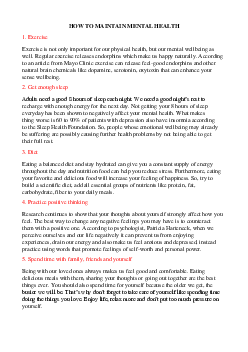




Preview text:
JUSTICE IN THE JUNGLE / FIGHTING
ANIMALSTRAFFICER/TRAFFICKING
. What are the negative impacts of wildlife trafficking?
Wildlife trafficking has many negative impacts on animals, people, and the environment. Some of the impacts are:
It threatens the survival of many endangered species, such as rhinos, elephants, tigers, and pangolins
It disrupts the balance and functioning of ecosystems, affecting biodiversity and ecosystem services
It fuels corruption, violence, and organized crime, undermining the rule of law and security
It poses risks to human health and well-being, as wildlife trade can spread diseases
and reduce livelihood opportunities
. How can an ordinary person help protect wild animals?
An ordinary person can help protect wild animals in many ways, such as:
Avoiding buying or consuming products made from endangered or illegally traded
wildlife, such as ivory, rhino horn, or shark fin
Supporting conservation organizations that work to protect wildlife and their habitats, such as WWF, WCS, or TRAFFIC
Educating oneself and others about the importance and value of wildlife, and raising
awareness about the threats and solutions to wildlife trafficking
Adopting sustainable and responsible practices that reduce the impact of human
activities on wildlife and the environment, such as recycling, reducing waste, and using renewable energy
. What are some animals that are on the brink of extinction?
Some animals that are on the brink of extinction are:
The Javan rhino, which is the rarest of the rhino species, with only around individuals left in the wild
The Amur leopard, which is the rarest of the big cats, with only around individuals left in the wild lOMoAR cPSD| 41487872
The Sunda Island tiger, which is the smallest of the tiger subspecies, with only around individuals left in the wild
The vaquita, which is the smallest and most endangered marine mammal, with only
around individuals left in the wild
The pangolin, which is the most trafficked mammal in the world, with millions of
them poached and traded every year
. What have been done to combat wildlife trafficking?
Some of the actions that have been done to combat wildlife trafficking are:
Strengthening laws and policies that prohibit and penalize wildlife trafficking, and
enhancing the capacity and coordination of law enforcement agencies to detect, deter,
and prosecute wildlife criminals
Improving the monitoring and management of wildlife populations and habitats, and
supporting the conservation and restoration of key wildlife areas
Developing and implementing social and behavior change campaigns that target
consumers and influencers of wildlife products, and reduce the demand and
acceptability of wildlife trafficking
Engaging and empowering local communities and stakeholders to participate in and
benefit from wildlife conservation, and providing alternative livelihoods and
incentives that reduce the reliance on wildlife trafficking.
Wildlife trafficking: the illegal trade, smuggling, poaching, capture, or collection
of endangered animals, their derivatives, or products
Poacher: a person who hunts or catches animals illegally, usually for commercial purposes
Trafficker: a person who transports, sells, or buys animals or animal products
illegally, often as part of a criminal network
Consumer: a person who purchases or uses animals or animal products, either legally or illegally.
Conservationist: a person who advocates or practices the protection and preservation
of wildlife and their habitats.
Ranger: a person who patrols and protects a natural area, such as a national park or
a wildlife reserve, from poachers and other threats.
Endangered: a term used to describe a species that is at risk of extinction, meaning
that there are very few of them left in the wild. lOMoAR cPSD| 41487872
Extinct: a term used to describe a species that no longer exists, meaning that all of them have died out.
Biodiversity: the variety and richness of life on Earth, including all the different species of
plants, animals, and microorganisms, and the ecosystems they form.
Ecosystem: a community of living and non-living things that interact with each other
and their environment, such as a forest, a coral reef, or a desert.
Combat wildlife trafficking: This is the overall goal of fighting against the
illegal wildlife trade, which threatens the survival of many species and the health
of ecosystems. It involves various strategies, such as disrupting the supply chains,
increasing the penalties, and enhancing the international cooperation.
Prevent illegal trade: This is the action of stopping the illegal wildlife trade from
happening in the first place, by addressing the root causes, such as poverty,
corruption, and lack of awareness. It also involves strengthening the legal
frameworks, improving the monitoring and enforcement, and providing
alternative livelihoods for the local communities.
Protect endangered species: This is the action of ensuring the survival and
recovery of the species that are at risk of extinction due to the illegal wildlife trade,
such as elephants, rhinos, tigers, and sharks. It involves creating and managing
protected areas, restoring habitats, and implementing conservation plans.
Report wildlife crime: This is the action of informing the authorities or relevant
organizations about any suspected or witnessed cases of illegal wildlife trade, such as
poaching, smuggling, or selling of wildlife products. It involves raising awareness
among the public, providing incentives and rewards, and ensuring the safety and anonymity of the informants.
Raise awareness: This is the action of educating and informing the public, especially
the consumers and the youth, about the negative impacts of the illegal wildlife trade on
the wildlife, the environment, and the society. It involves using various media
platforms, campaigns, and events to spread the message and inspire action.
Support conservation: This is the action of providing financial, technical, or
moral support to the organizations and individuals that are working to combat
wildlife trafficking and protect endangered species. It involves donating,
volunteering, advocating, or partnering with the conservation groups.
Reduce demand: This is the action of decreasing the consumer demand for the
illegal wildlife products, such as ivory, rhino horn, tiger parts, and shark fins. It
involves changing the attitudes, beliefs, and behaviors of the consumers, especially in
the Asian markets, where the demand is high. It also involves promoting the use of
alternative products that are legal and sustainable. lOMoAR cPSD| 41487872
Enforce laws: This is the action of implementing and applying the existing laws
and regulations that prohibit and punish the illegal wildlife trade. It involves
improving the capacity and coordination of the law enforcement agencies, such as
customs, police, and judiciary. It also involves increasing the detection,
investigation, and prosecution of the wildlife crimes.
Prosecute traffickers: This is the action of bringing the perpetrators of the illegal
wildlife trade to justice, and imposing appropriate sanctions and penalties. It
involves enhancing the legal systems, ensuring the due process, and applying the
international conventions and agreements. It also involves holding the traffickers
accountable for their crimes and deterring others from engaging in the trade.
Rescue animals: This is the action of saving and rehabilitating the animals that
are victims of the illegal wildlife trade, such as those that are captured, injured, or
orphaned. It involves providing medical care, shelter, and food to the animals, and
releasing them back to the wild if possible. It also involves preventing the animals
from being exploited or abused in captivity.
Advantages and Disadvantages of fighting animals trafficking
Fighting animals trafficking is a noble and urgent cause, as it endangers many wildlife
species and harms the environment. Here are some of the advantages and disadvantages
of fighting animals trafficking: Advantages:
It protects the rights and welfare of wild animals, who are living beings that deserve respect and dignity
It preserves the diversity and richness of life on Earth, which is essential for the
health and balance of ecosystems and the provision of ecosystem services
It contributes to the security and stability of society, as it reduces the risks of
corruption, violence, and disease transmission that are associated with wildlife crime
It supports the development and prosperity of local communities, as it provides
them with alternative livelihoods and incentives that are based on sustainable use and conservation of wildlife Disadvantages: lOMoAR cPSD| 41487872
It requires a lot of resources and coordination, as it involves multiple actors and
sectors, such as law enforcement, judiciary, customs, wildlife management, education, and media.
It faces many challenges and obstacles, such as weak laws and policies, lack
of awareness and political will, high demand and profitability, and complex
and transnational networks of traffickers.
It may have unintended consequences, such as displacing the problem to other
areas or species, creating conflicts or resentment among local people, or affecting
the cultural or religious values of some communities.




